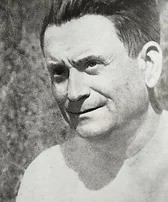František Bidlo
František Bidlo was an artist who illustrated during the early to mid 19th century, and the pieces exhibited here are from that period. Bidlo was the youngest born into a working-class family in Prague. Bidlo showed an early talent for drawing. He wanted to go to art school, but his father considered this bourgeois and impractical, and sent him to Vienna to apprentice as a hatter. Soon after completing his apprenticeship in 1915, Bidlo was called up for military service in World War I. He survived three years as an infantryman with the Austro-Hungarian army on the Italian front. At the end of the war Bidlo found employment at Jan Weiss’s hat factory and shop. He moonlighted as an advertising designer and illustrator, often selling his illustrations directly out of the shop.
Politically radicalized by his experience of war, Bidlo joined the Communist Party of Czechoslovakia in 1920. In 1925 he began publishing regularly in Rudé Právo (Red Justice), the Party’s daily newspaper, producing revolutionary propaganda images whose style was strongly influenced by Russian constructivism.
Bidlo soon found a warm welcome in avant-garde artistic circles. In 1933 he stopped working for Rudé Právo and moved away from propaganda work towards political satire. He became editor of Simplica, an influential satirical magazine and his political cartoons, characterized by a dark humor, appeared in periodicals in Prague and abroad. His contemporary and friend, the celebrated poet František Halas, wrote: “His clean line is like a lasso, roping in its subject and squeezing the truth out of it”.
His lampooning of Hitler and unflinching criticism of Nazism brought his work widespread attention, not least from German authorities. In 1935 the German embassy successfully lobbied the Czechoslovak government to shut down Simplica on libel grounds, and Bidlo found it increasingly difficult to find willing publishers for his work.
In March 1939 Germany occupied the Czech lands. Bidlo reportedly refused an offer to work for the occupation press. Around 1940 he went into hiding, staying with friends and exchanging drawings for food. He evaded the Nazi authorities for several years, but in January 1945 an informer gave his location away, and he was taken to the Terezín concentration camp. There he contracted typhoid fever and died on May 9, the same day that the Soviet army ousted the Nazis from Prague.
Related Events
